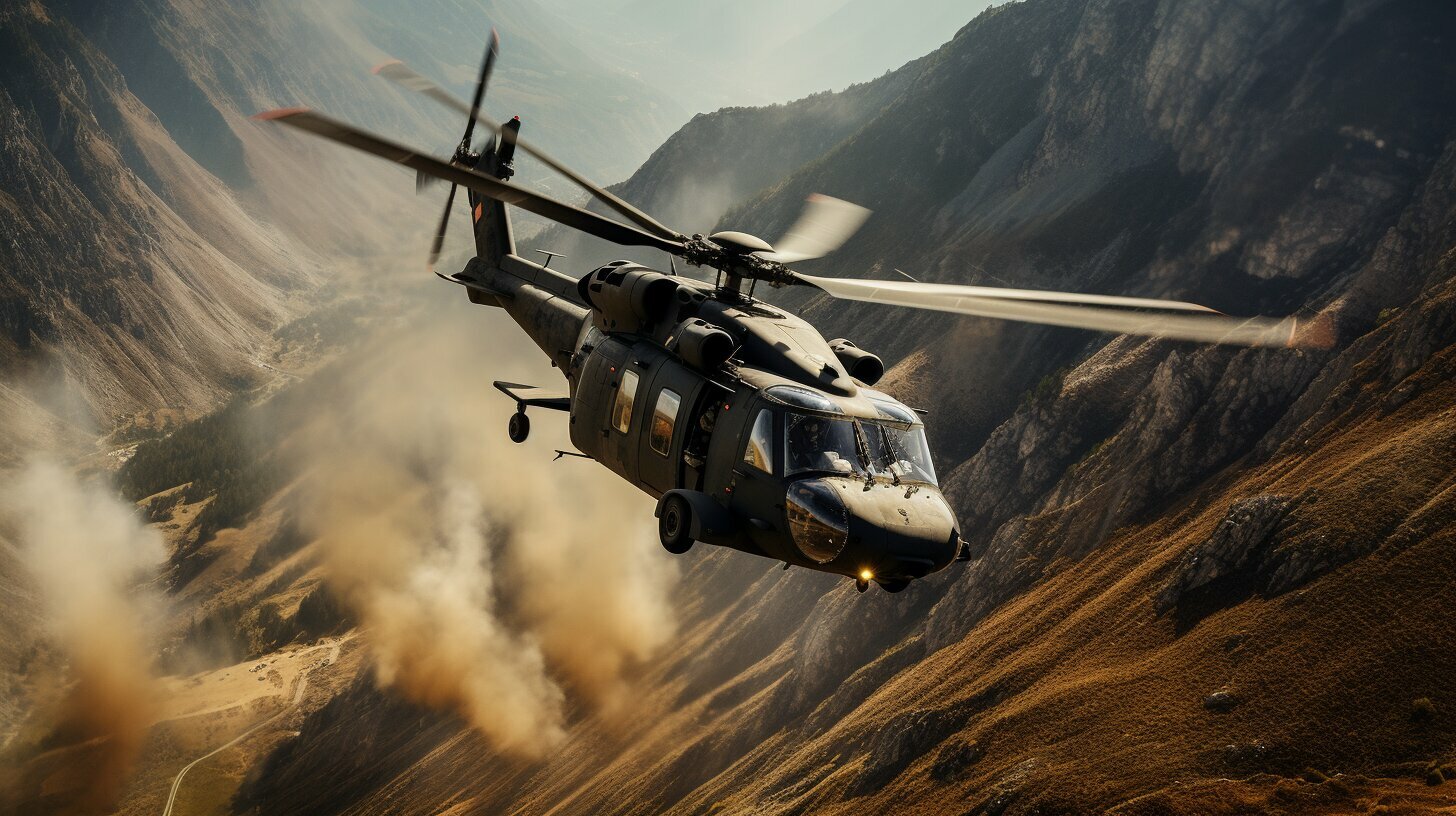
Aerodynamic Problems in Helicopter Design
Helicopter design is a complex and fascinating field, with engineers constantly striving to improve the efficiency, safety, and performance of these incredible machines. At the heart of this challenge lies the management of aerodynamic problems that can influence every aspect of helicopter flight.
From rotor blade shapes to fuselage design, understanding and addressing these issues has never been more critical in achieving optimum helicopter performance. Join us as we explore some of the most pressing aerodynamic problems in helicopter design and delve into innovative solutions employed by industry experts to overcome them.
Understanding Aerodynamic Problems In Helicopter Design
The aerodynamic problems in helicopter design are diverse and include issues such as vibration, ground effect, weight balance, and high-speed flight hazards.
Vibration
Vibration is a significant aerodynamic challenge faced by helicopter designers. In helicopters, the main vibration source is rotating components such as rotor blades and shafts.
These vibrations can lead to an uncomfortable experience for passengers and pilots, increased fatigue on critical structural elements, and even reduced aircraft performance.
To address this issue in helicopter design, engineers utilize active vibration control systems that help mitigate these unwanted effects. For example, incorporating tailored blade designs with varying stiffness or implementing advanced materials with superior damping properties aid in minimizing vibrations.
Another approach involves utilizing real-time sensors for monitoring vibrations during flight and adjusting certain aspects of the aircraft accordingly to maintain a smoother ride while preserving overall performance without compromising safety standards.
Retreating Blade Stall
Retreating blade stall is a phenomenon that occurs during a high-speed forward flight in helicopters. The retreating blade moves backward relative to the direction of flight, while the advancing blade moves forward. As airspeed increases, the airflow over the retreating blade begins to separate from its surface, causing a disruption in lift and stability.
To counteract this problem, helicopter designers incorporate various techniques into their rotor blades’ design, such as twist and sweep angles or advanced airfoil technologies. They may also use computational fluid dynamics (CFD) simulations to analyze and optimize aerodynamic performance under different operating conditions.
Ground Effect
Ground effect is a phenomenon that occurs when an aircraft flies close to the ground. It is caused by the interaction of the aircraft’s wing or rotor with the ground. In the case of a helicopter, the ground effect occurs when the helicopter’s rotor blades are close to the ground. The ground reflects the downwash from the rotor blades, which creates a cushion of air under the helicopter. This cushion of air reduces the amount of lift that is required to keep the helicopter in the air, which makes it easier for the helicopter to hover and land. Here are some of the drawbacks of the ground effect:
- Reduced maneuverability: The ground effect reduces the maneuverability of the helicopter. This is because the helicopter is less responsive to control inputs.
- Increased risk of settling with power: Settling with power is a condition that occurs when a helicopter is in ground effect, and the power is increased. The increased power causes the helicopter to rise out of the ground effect, which can lead to a sudden loss of lift and a crash.
- Reduced tail rotor effectiveness: Ground effect reduces the effectiveness of the helicopter’s tail rotor. This is because the air cushion under the helicopter reduces the amount of airflow over the tail rotor, making it more difficult to control the helicopter.
The ground effect is a problem in helicopter design because it can reduce the maneuverability and safety of the helicopter. Helicopter designers must consider ground effects when designing helicopters and operating helicopters.
Compressibility
Compressibility is a significant aerodynamic problem that affects helicopters because it can cause a number of undesirable effects, such as:
- Increased drag: Compressibility causes the air to become denser, which increases the drag on the helicopter. This can make it more difficult for the helicopter to fly at high speeds.
- Reduced lift: Compressibility can also reduce the lift that is generated by the helicopter’s rotor blades. This can make it more difficult for the helicopter to hover or climb.
- Vibration: Compressibility can cause the helicopter’s rotor blades to vibrate, which can be uncomfortable for passengers and crew.
- Structural damage: In extreme cases, compressibility can cause structural damage to the helicopter.
Helicopter designers must take compressibility into account when designing helicopters. They do this by using swept-back rotor blades and limiting the helicopter’s speed. Helicopter pilots must also be aware of the effects of compressibility and take steps to avoid them. For example, they should avoid flying at high speeds in gusty weather.
Weight And Balance Issues
Proper weight and balance distribution is crucial to the safe operation of a helicopter. Helicopters are designed with specific limitations on how much weight they can carry, often referred to as maximum gross weight.
If the aircraft exceeds this limit, it can become unstable and difficult to control, making it prone to accidents. In addition, even if the helicopter remains within its weight limits, uneven weight distribution can cause significant problems during flight.
To ensure proper balance and weight distribution, helicopter designers utilize computer models and simulation techniques that analyze where loads should be placed in relation to each other.
Advanced software tools can also simulate various scenarios, such as turbulence or unexpected gusts of wind, to determine how these factors will impact overall balance during flight.
High-Speed Flight Hazards
High-speed helicopter flight can be hazardous due to several aerodynamic factors, including compressibility and retreating blade stall. As mentioned earlier, compressibility is the reduction in air pressure as a result of high airspeeds, which causes shock waves on the helicopter’s surface that can lead to instability and loss of control. Retreating blade stall occurs when the speed of one rotor blade exceeds its critical value, leading to a decrease in lift and increased drag on that side of the helicopter.
To minimize these hazards during high-speed flights, designers use various strategies, such as optimizing rotor blade design for maximum performance at high speeds and incorporating active vibration control systems into helicopters’ structures.
Additionally, comprehensive wind tunnel testing is conducted to identify potential issues with aerodynamic stability before they become problematic during actual flight operations.
Design Strategies For Optimum Helicopter Performance
Design strategies for optimum helicopter performance include the use of active vibration control systems, blade twist and sweep, rotor disc tilt, aerodynamic optimization, reduction of wind forces and vibrations, and advanced blade design.
Active Vibration Control Systems
Active vibration control systems play a crucial role in reducing aerodynamic problems in helicopter design. They detect vibrations and produce counteracting forces to mitigate their effects on the rotor system. Here are some examples of active vibration control systems used in helicopter design:
- Active Blade Control: This technology involves installing sensors on the rotor blades that measure vibrations and a controller that uses this data to adjust the blade pitch or apply corrective forces when necessary.
- Active Suspension Systems: These support structures use electric actuators to counteract ground-induced vibrations.
- Active Damping Systems: These are designed to absorb vibrations by introducing an equal and opposite force.
- Active Mass Balancing: This technique involves adding weights to the rotor system to counteract unbalanced centrifugal forces generated during flight.
These active vibration control systems help improve helicopter safety, efficiency, and performance. For example, they can reduce pilot fatigue by reducing cockpit noise levels and improve the long-term durability of helicopter components by minimizing wear and tear caused by excessive vibration.
Achieving the optimum performance of these systems requires a multidisciplinary approach that combines computational fluid dynamics (CFD), advanced materials, manufacturing techniques, and integrated design and testing processes. Utilizing these technologies can overcome aerodynamic problems in helicopter design, improving lift and drag capabilities while enhancing forward flight performance for safer and more efficient operations.
Blade Twist And Sweep
In helicopter aerodynamics, blade twist and sweep refer to two design strategies used to improve the performance of rotor blades. Blade twist involves changing the angle of each blade from the root to the tip, with a greater angle at the root and a lesser at the tip.
Blade sweep refers to bending blades back toward their trailing edge, which reduces interference between tips and thus improves efficiency. The combination of these two methods can significantly increase the lift-to-drag ratio, reduce noise, improve handling characteristics and extend rotor life.
Helicopter designers now use advanced computational fluid dynamics (CFD) software to optimize both twist and sweep according to specific performance criteria such as power consumption, maximum speed, or maneuverability in high-altitude environments.
Rotor Disc Tilt
The tilt of the rotor disc is a crucial factor in helicopter design that affects stability, control, and maneuverability. The disc tilt refers to the angle at which the rotor blades are attached to the hub relative to the helicopter’s fuselage. A slight change in this angle can substantially affect lift, thrust, and drag forces acting on each blade as it moves through its rotation cycle.
To illustrate further, when hovering, helicopters generate lift by creating low pressure above their rotors’ blades while maintaining a high-pressure region below them. In contrast, when transitioning to forward flight mode from a stationary position (hovering), these same principles apply but with much higher airspeeds over each blade.
Importance Of Aerodynamic Design In Helicopters
Aerodynamic design in helicopters is critical for ensuring safety, increasing efficiency, and improving overall performance, making it essential for designers to address these problems in their designs.
Safety
Safety is a top priority in helicopter design, and aerodynamic considerations play a critical role in ensuring the safety of these aircraft. For example, ground effect can reduce the pilot’s ability to control altitude during takeoff or landing. Blade stall is another common issue that can lead to loss of lift and sudden drops in altitude. To address these safety concerns, designers must consider several design factors to maintain strict safety standards.
Efficiency
Efficiency is a major concern in helicopter design, impacting several performance areas. Efficient designs are paramount for maximizing power output while minimizing fuel consumption. Aerodynamic optimization can improve the efficiency of rotor blades, which are critical components that generate lift and control the flight direction. A well-designed blade with reduced drag translates to better overall flight efficiency.
Another way to boost efficiency is through weight reduction, as heavy helicopters expend more energy and consume more fuel than lighter ones. Also, aerodynamic problems such as retreating blade stall or compressibility can affect hover or forward flight performance, leading to inefficiencies in operation and higher maintenance costs.
For example, comprehensive optimization approaches have been used to analyze different aspects of rotor blade performance, like acoustics and stealth characteristics. One research study found that adding serrated trailing edges to helicopter rotor blades could reduce noise levels by over 30%, which would make helicopters less noisy and more efficient in urban environments where noise pollution is a significant issue.
Performance
Performance is a crucial aspect of helicopter design that encompasses various factors like speed, maneuverability, and efficiency. To achieve optimal performance, designers must consider many aerodynamic problems, such as blade stall and weight distribution.
Addressing Aerodynamic Problems In Helicopter Design
Addressing aerodynamic problems in helicopter design requires the use of advanced techniques such as computational fluid dynamics, advanced materials and manufacturing processes, and integrated design and testing processes which are crucial for improving safety, efficiency, and performance.
Using Computational Fluid Dynamics
Computational Fluid Dynamics (CFD) is an advanced simulation technique used to analyze complex fluid dynamic systems. In helicopter design, CFD plays a vital role in evaluating and improving the aerodynamics of rotor blades. Here are some ways CFD can be used:
- Predicting the airflow around rotor blades to identify performance issues and enhance design.
- Analyzing blade-vortex interactions during forward flight and hover conditions, which can affect the helicopter’s stability.
- Modeling ground effect on rotor blades to improve performance during takeoff and landing.
- Optimizing blade twist and taper ratio for better lift-to-drag ratios.
- Evaluating the effects on rotor blade performance during high-speed flight.
- Reducing wind forces and vibrations through aerodynamic optimization using CFD simulations.
- Conducting virtual wind tunnel tests to examine the dynamic characteristics of rotary wing devices, such as stall and blade stall, vortex ring state, and autorotation.
- Studying directional control during various flight conditions to improve helicopter handling.
- Designing airfoils with specific chord lengths and distribution functions using CFD techniques, resulting in more efficient lift generation.
- Integrate design processes using CFD and other tools like finite element analysis (FEA), structural dynamics analysis (SDA), controls analysis, and others for a more comprehensive approach to helicopter design optimization.
The use of computational fluid dynamics is crucial in addressing aerodynamic problems in helicopter design efficiently while balancing costs and delivering improved efficiency, safety, and performance.
Advanced Materials And Manufacturing Techniques
Advanced materials and manufacturing techniques have revolutionized the design of helicopter rotor blades. Some of the ways in which they have improved helicopter aerodynamics include:
Carbon Fiber Composites: Advanced composite materials such as carbon fiber are now commonly used in helicopter rotor blade construction. These materials offer high strength-to-weight ratios, making them an ideal choice for reducing blade weight without compromising rigidity.
Nano-Structured Materials: The use of nanostructured materials has also gained popularity in helicopter design due to their exceptional mechanical, thermal, and chemical properties. These materials can improve the durability and longevity of rotor blades while reducing maintenance costs.
Additive Manufacturing: Rapid prototyping via 3D printing has significantly reduced lead times and costs associated with traditional manufacturing methods. Designers can now quickly test different approaches to optimization, leading to faster development cycles.
Surface Modification: Researchers are exploring surface modifications on rotor blades to reduce drag and vibration, improving lift-to-drag ratios for better performance.
Ceramic Matrix Composites (CMCs): CMCs are lightweight and strong ceramic fibers embedded in a matrix material that provides excellent heat resistance, toughness, wear resistance, and durability for use in extreme environments.
The use of advanced materials and manufacturing techniques is essential not only for developing efficient rotor blades but also for improving overall safety standards in helicopter design. With continued innovation in this field, designers can find new ways to enhance performance while meeting regulatory guidelines effectively.
Advanced Airfoil Technologies
Advanced airfoil technologies play a significant role in optimizing the aerodynamic performance of helicopter rotors. Helicopter designers can employ advanced airfoil shapes to achieve higher lift-to-drag ratios, reduce drag, and enhance efficiency.
For example, one study proposed a new ‘blade tip geometry‘ for hover flight that significantly improved the maximum lift coefficient while reducing power requirements. Several challenges still exist in developing advanced airfoils that meet specific application requirements while minimizing costs. It is crucial to employ high-fidelity modeling tools with accurate flow simulations during the design and testing phases to ensure desired outcomes. Furthermore, wind tunnel testing is essential for verifying theoretical models and refining designs before deployment in actual helicopters.
Integrated Design And Testing Processes
The aerodynamic design of a helicopter is a complex process that requires an integrated approach to testing and development. Here are some key aspects of integrated design and testing processes:
- Computational Fluid Dynamics (CFD) is used to analyze the performance of different rotor blade configurations under varying conditions.
- Wind tunnel testing is conducted to validate CFD results and provide more accurate data for design improvements.
- Testing also includes full-scale helicopter flight tests, which allow designers to evaluate actual performance in real-world scenarios.
- Integrated design teams work together to ensure that all components of the helicopter work together efficiently, including the aerodynamic design of the rotors, fuselage, and other components.
- Optimization techniques are used to improve overall efficiency, safety, and performance while reducing costs.
- Advanced materials are utilized in rotor blade construction to improve durability and reduce weight.
- Designers also use advanced manufacturing processes such as 3D printing to create prototype blades quickly and efficiently.
Integrated design and testing processes are essential for improving the aerodynamic efficiency of helicopters. By utilizing advanced technologies and collaborative approaches, designers can develop safer, more efficient helicopters that can meet the growing demands of modern aviation industries while minimizing environmental impact.
Final Thoughts
Aerodynamic problems in helicopter design are complex and multifaceted, ranging from vibration to ground effect. However, designers can implement various strategies for optimum performance. The importance of aerodynamic design cannot be overstated, as it impacts safety, efficiency, and performance. Addressing these issues requires the use of advanced technologies like computational fluid dynamics and materials manufacturing techniques. Overall, improving the design and aerodynamic efficiency is integral to the progress of helicopter technology.





